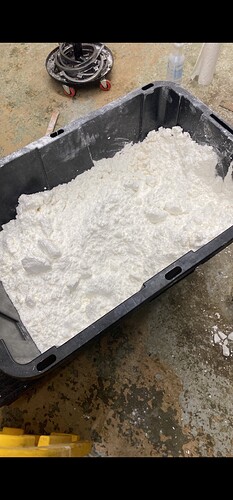No matter what form you have dissolving in RP-HPLC mobile phase buffer is going to “white wash” that sample.
There is only one study where the HPLC MS researchers wanted to avoid the possibility of “RP-HPLC” mobile phase and column effects on the same. You skip the HPLC analysis and do FIA (flow injunction analysis “ directly into the ion spray port of the mass spec.
Using Cerriliant standard THCA this is what you get

High Resolution Accurate Mass (HRAM) FIA Experiments
A quadrupole time-of-flight (QTOF) mass spectrometer (Agilent Technologies) equipped with a dual ESI source was used. The QTOF was operated in ESI+ mode over the mass range of 100–500 m/z . Samples were directly infused into the electrospray source with a syringe pump at a rate of 200 µL/h.
P.J.W. Stone, S. D’Antonio, N.C. Lau, W.A. Hale, and A. Macherone, Cannabis Science and Technology 3 (3), 34–40 (2020).
Unless you are doing FIA…you are only looking at mobile phase controlled properties of cannabinoic acid “forms”.
However, the elution of cannabinoic acids vs pH of mobile phase tell you a lot about physiochemical properties in the pH range 2.5 to 4.5.
Sambo Creeks ionic charge separator of trichome heads produces an excellent material to do the ICP-AES…analysis of that restricted volume element….we should know that number soon especially the K+ and Ca++. Knowing the upper limit of THCA concentration in the trichome head fraction is very helpful. If you had a tightly bound complex of say K+ with the anion fraction that may exist…HPLC would mask it. Remember, it does not have to be one form or the other, it is a mixture ! Exactly what the chromatogram peaks represent unless you force them to pH 2 or pH 5 with selective buffer. Delta elution order per delta pH change is instructing you the mixture ratio is changing. But no matter what intermediate mixture you have you only see one peak.
Nice crystals and “butane works”.
@Octave, only about 1 in 20 Ph.D. Chemists have studied Studied “Separation Science” as a formal graduate level topic. If you had, a quick look at any RP-HPLC chromatogram of Cannabinoids would immediate alert you to the fact that something odd is going on. It depends on pH mobile phase buffer, but in general you will see CBDA/CBD elution order is reverse that of THC/THCA elution order. ( Like a standard C18 column and using a water methanol/ formic or acetic buffer as Mobile phase.)
So what ever is going on with THCA is not happening with CBDA. So the question is: what is the “form” trapped in the Nonpolar C!8 column support, R-COOH proper, or an Intramolecular H-bonded Anion form, once formed can partition into non polar…by itself or in association with the neutral form (acid homologous base pair). The Decarb- kinetic studies of H. Perrotin-Brunel et al. / Journal of Molecular Structure 987 (2011) 67–73…strongly suggest that some small acid or water is trapped in THCA isolates.
There is some odd behavior exhibited by purified THCA that is not completely explained.
Octave, your crystals and lab work to produce them, looks as good as one can expect in the industry. So hopefully this extended discussion brings some attention to your product and stimulates further studies about the detailed chemistry of THCA both anionic and neutral forms.
When you look at someone doing HPLC ESI MS or one of the many hybrid forms of MS, look closely at the choice of mobile phase of the HPLC.
Addendum edit:
Here is an example of someone who clearly understands the “mobile phase white wash “ problem:
“The isocratic LC conditions were developed to separate the target analytes from the family of congeners likely to be present in C. sativa extracts, and to generate the best peak shape. Formic acid was used to buffer the HPLC mobile phase to generate a single conjugate of the acids during chromatographic separation.”
A reliable and validated LC-MS/MS method for the simultaneous quantification of 4 cannabinoids in 40 consumer products
“ using an isocratic mobile phase of water (0.1% formic acid): acetonitrile (0.1% formic acid) 10:9”
Here we have a case where 0.1 % formic and the pKa alteration of the 90% ACN b phase….probably achieves a high ratio of R-COOH/R-COO-. Interestingly, when you do ESI of standard THCA you get the 357-H, and you simply do not know whether your are doing a gas phase ionization of the carboxyl with remote loss of H or the H loss is anion.??? the dynamics of the ESI process when you get down to it, are rather mysterious when it comes to R-COOH vs R-COO- as conjugates. Someone needs to do direct FIA of THCA and CBDA in a suitable buffer, pH 5 MeOH/H20 90/10 and MSMS, negative mode. N2 gas.



